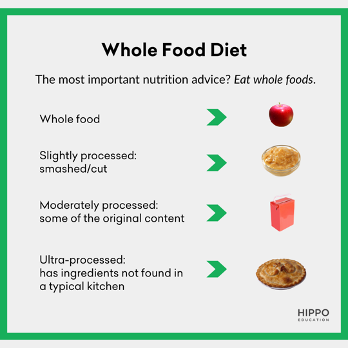The Whole-Food, Plant-Based Diet

As primary care clinicians, we play a crucial role in helping our patients make healthier food choices. But with all the contradicting information out there, sifting through nutrition evidence can be daunting.
One diet that has evidence for helping prevent disease and promote better health is a whole-food, plant-based diet.
This diet focuses on eating whole grains, fruits and vegetables that have undergone minimal processing. Studies have shown that this approach is associated with health promotion and disease prevention, and that a plant-based diet is a cost-effective, low-risk intervention that may lower BMI, BP, HgbA1c and cholesterol levels.
As Michael Pollan says in his book In Defense of Food: “Eat food. Not too much. Mostly plants.”
Eat Whole Foods
In a society where fast and easy ultra-processed foods dominate the food landscape, adopting a healthy diet can be challenging. One easy way to start is to focus on the “whole foods” part of whole-food, plant-based nutrition. This means eating the least-processed version of the food – the version that is closest to the form in which it was grown.
There are three levels of food processing:
- Slightly processed: the food is smashed or cut, but nothing is removed. 80% of caloric intake should come from whole or slightly processed foods.
- Moderately processed: the food may be mixed with ingredients available in a typical kitchen but still possesses some of the original content. For example, rolled oats (only the shape has changed) and apple pie made at home are moderately processed foods.
- Ultra-processed: food created in a processing plant that contains ingredients not found in a typical kitchen. These foods are made in a lab and designed to be addictive. Ultra-processed foods have been shown to contribute to the development of obesity, diabetes, cardiovascular diseases, depression, cancer, and renal and liver diseases.
We can use apples as an example to help us and our patients visualize food processing. The whole food is the apple. The minimally processed version would be applesauce with no added ingredients. Apple juice would be moderately processed, as would apple pie made at home, but packaged apple pie from a grocery store would be ultra-processed.
Eat the Rainbow
In plant-based eating, 95% of calories should come from vegetables, fruit, whole grains, legumes, nuts and seeds. “Eat a rainbow every day” is a great way to help our patients think about the way they can vary their dietary patterns and get the nutrients they need. The colors of food have significance:
- Red, orange and yellow foods have vitamin C, beta-carotene, vitamin A, potassium, zeaxanthin, and flavonoids.
- Green foods have iron, calcium, magnesium, zinc, potassium, folate, vitamin K, vitamin C, vitamin A, and phytonutrients.
- Blue and purple foods have flavonoids, resveratrol, and anthocyanins.
- White foods have polyphenols and starches.

Getting Started with a Whole-Food, Plant-Based Diet
Patients may worry that this type of diet may be expensive. But it doesn’t have to be. Affordable whole foods can be found in any grocery store. The American Council of Lifestyle Medicine’s guide to eating a whole-food, plant-based diet on a budget is a great resource for patients.
Helping people change the way they eat can be challenging. It’s important to make food fun, and to help patients see that a whole-food, plant-based diet isn’t restrictive; in fact, it invites in a wide variety of flavorful foods.
Don’t let perfection be the enemy of good; making small changes will help our patients improve their health over time. The more we learn about evidence-based nutrition, the more we can stop the spread of misinformation about food.
For a deeper dive on the health benefits of a whole-food, plant-based diet, listen to this episode on the Primary Care RAP podcast. See our full chapter summary here.
Practice-Changing Education
Experience education that goes beyond theory. Explore Hippo Education’s offerings below.



